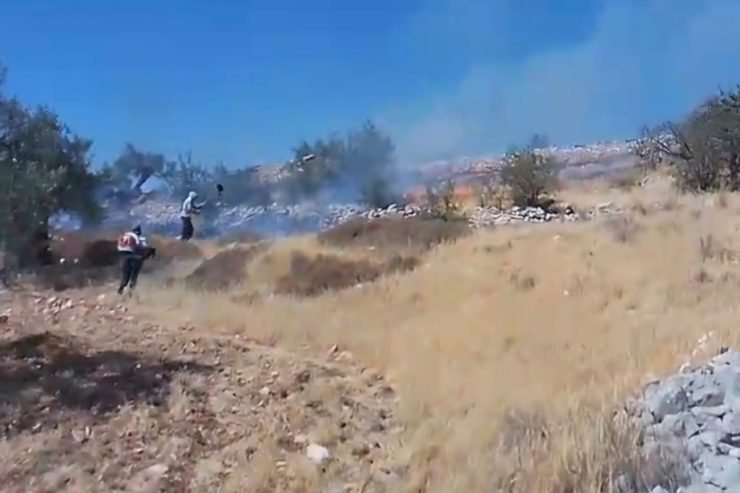Taybeh Church Fire Incident Sparks Controversy and Accusations of Anti-Christian Violence
A fire near the 1,500-year-old Church of St. George in the Palestinian village of Taybeh has ignited a firestorm of controversy and accusations of anti-Christian violence. The incident, which occurred on July 7, 2024, has drawn international attention and raised concerns about escalating tensions in the region.
Greek Orthodox Patriarch of Jerusalem Theophilos III, during a visit to the site with other religious leaders and diplomats, alleged that “radical Israelis from nearby settlements intentionally set fire near the town cemetery and the church.” He characterized the incident as a “targeted attack” against the Christian community, a symbol of peaceful coexistence in the region. However, Patriarch Theophilos did not provide evidence to substantiate his claims, raising questions about the veracity of the accusations.
Despite the lack of evidence, several international media outlets, including The Telegraph, reported the allegations as fact, further fueling the controversy. The Telegraph’s coverage, in particular, has been criticized for its biased reporting and inflammatory language, with its headline proclaiming that “Israeli settlers burn down ancient Christian town in the West Bank.” This headline was misleading, as the town itself was not burned down, and even the article’s content did not support such a drastic claim.
The Telegraph article, written by Iona Cleave, presented the accusations as undisputed facts, describing alleged actions by Israeli settlers with vivid and seemingly eyewitness detail, despite a lack of quoted sources or witnesses within the article. The article’s dramatic narrative claims settlers “crept up” to the church ruins, lit a fire, and intentionally spread the flames using leaf blowers. This narrative, however, contradicts a report from the Israeli news outlet TPS-IL, which cited an Israeli shepherd who claimed to have been present at the scene and attempted to extinguish the fire. This shepherd, according to TPS, was then confronted by Palestinians who emerged from a nearby cemetery and threw objects at him.
Adding further complexity to the situation, TPS also reported that Israeli settlers were actually using leaf blowers to put out the fire, a claim supported by a still image from the scene. The use of leaf blowers in fire suppression is a recognized technique, though it can also exacerbate fires under certain conditions. The Telegraph article failed to acknowledge this alternative explanation, focusing solely on the narrative of intentional arson by Israeli settlers. This selective reporting, combined with the lack of evidence presented by Patriarch Theophilos, raises serious questions about the accuracy and impartiality of The Telegraph’s coverage.
Further complicating the narrative, TPS reported two additional fires in the vicinity of the church compound on July 8 and 11. A Jewish farmer, whose farm is adjacent to the church, reported these fires to the police, claiming that someone had intentionally set fire to the grazing area used by his shepherd. TPS stated that they had obtained time-stamped documentation of these reports, casting further doubt on the narrative of settler-initiated arson. Despite this evidence, The Telegraph’s article primarily focused on the accusations against the settlers, devoting minimal space to the official Israeli responses.
The Telegraph article did eventually include statements from the Israel Police and the IDF. The police confirmed receiving arson reports from residents and pledged a thorough investigation. The IDF, even more definitively, stated that the fires near the church “were extinguished by Israeli civilians.” However, these statements were relegated to the final paragraphs of the article, minimizing their impact and undermining their potential to challenge the dominant narrative of settler culpability. This placement, coupled with the inflammatory headline and biased framing of the article, effectively marginalized the Israeli perspective and reinforced the pre-determined conclusion of anti-Christian settler violence.
The handling of the Taybeh church fire incident by The Telegraph highlights the dangers of biased reporting and the importance of journalistic integrity. By presenting unsubstantiated accusations as fact, selectively choosing evidence, and marginalizing alternative perspectives, The Telegraph has not only misrepresented the incident but also potentially contributed to escalating tensions and mistrust in an already volatile region. This incident serves as a stark reminder of the need for balanced and evidence-based reporting, particularly in sensitive and complex situations where factual accuracy is crucial to fostering understanding and promoting peace. The Telegraph’s failure to adhere to journalistic standards has transformed their report from a news piece into an act of advocacy, undermining their credibility and potentially exacerbating the very conflict they claim to be reporting on.


